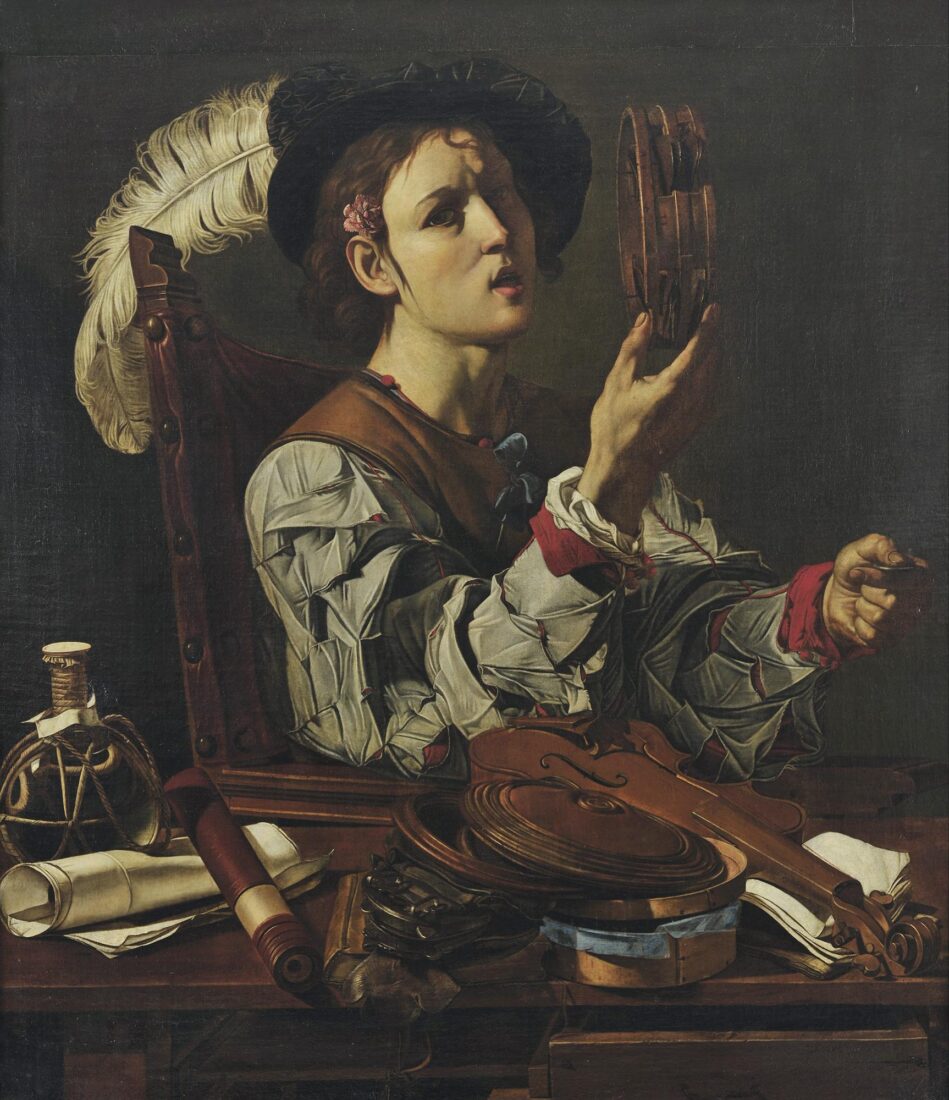We use cookies to make our site work properly, to personalize content and ads, to provide social media features and to analyze our traffic. We also share information about how you use our site with our social media, advertising and analytics partners. Read the Cookies Policy.

Cecco del Caravaggio (Boneri ή Buoneri Francesco)
Young Musician in a Workshop of Musical Instruments or Allegory of the Five Senses, ca. 1620 - 1625
Oil on canvas, 117 x 98 cm
Alexandros Soutzos Bequest
This painting, originally entered in the archives of the National Gallery as a work by Michelangelo Merisi da Caravaggio, was later attributed to Cecco del Caravaggio by Roberto Longhi. The identity of the painter called Cecco del Caravaggio was unknown. He was believed to be alternately French, Spanish, even Dutch, whereas Gianni Papi identified him as the Italian Francesco Boneri (G. Papi, “Cecco del Caravaggio,” Nuova Memoria, Florence, 1992).
Cecco del Caravaggio (Cecco is short for Francesco) worked in Italy during the first half of the 17th century. Mancini, in “Considerazioni sulla Pittura”, c. 1620, refers to a Francesco, called del Caravaggio, as an admirer and imitator of Caravaggio. It seems that the high regard Francesco had for the Lombardian painter, and his ability to imitate the master, gave him the pseudonym del Caravaggio.
This painting has generated much debate over its content. Roberto Longhi chose the title “Musical Instrument Maker” on the basis of the round object that the young man holds in his hand, which he seems about to place on the tambourine. Besides the violin – and it’s unclear whether this has been constructed or simply repaired – there is nothing else to indicate an association with this occupation. Furthermore, the array of objects in the foreground, which, aside from the violin, have nothing to do with music, heightens the mystery surrounding its theme. The painting’s enigmatic and allegorical character allows us to speculate that it was directed towards connoisseurs – a reason why A. Cottino chose the title “Allegorical Portrait of a Youth with Musical Instruments” (A. Cottino, “La natura morta caravaggesca” in “La natura morta in Italia”, vol. II, p. 726).
On the occasion of the publication of the work in the 2018 Calendar, in the introductory text, the director of the Athens National Gallery, Marina Lambraki Plaka, commenting on the painting, proposes the title Young Musician in a Workshop of Musical Instruments or Allegory of the Five Senses”: “The work was originally, and for many decades, known under the title given by the eminent Italian art historian Roberto Longhi: Musical Instrument Maker. Under this title, it was featured in many international exhibitions. The young man’s sumptuous dress, however, the feathered hat, and the carnation behind the ear, his noble features, as well as his placement in the composition, preclude this identification. Craftsmen are commonly seen in contemporary paintings and accounts of the time to wear casual, worn-out clothes, leather aprons, and their rough figure often betrayed their low-class origin.
The young nobleman is seated on a luxurious chair, with a high backrest, behind a bench or table, with open drawers that face the viewer. This was a common artists’ device aimed at making the viewer identify with the invisible interlocutor of the depicted figure. But what is the identity of the figure that does not appear in the painting? A musical instrument dealer? In this case, his young patron is offering him a coin in his left hand as payment for the tambourine in his right. A musical dilettante who was also a musical instrument collector? We may never know. What about the objects scattered on the bench, masterfully painted in illusionistic verisimilitude? A violin, a small telescope, hastily folded document scrolls, empty round boxes, and a wine carafe. Let’s attempt a new interpretation here: Whatever the thematic pretext, this enigmatic scene may be an allegory of the five senses: the musical instruments, the inaudible sound of the tambourine and of the song suggested by the boy’s half-open mouth all evoke the sense of hearing; his left hand, holding the coin, denotes touch – as does the feather that adorns the young man’s hat; the small telescope and the painting as a whole are a celebration of sight; smell is suggested by the carnation – that explains why the fragrant flower was introduced, placed behind the young man’s ear. The wine carafe, finally, is a tribute to the fifth sense, taste. This is how the mystery of the juxtaposition of such disparate objects in this captivating painting can be solved.”
Gianni Papi dated this painting to the mid-1620s. A second version of the picture with some variations mostly in the garments, the facial expression and the position of the musical instrument held by the youth, is in the Wellington Museum in London.

